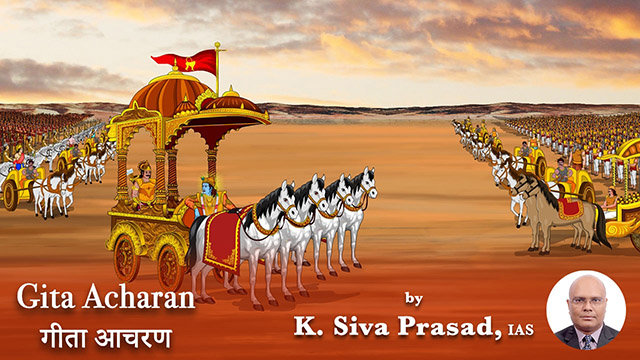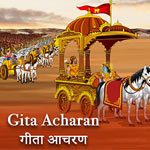
After explaining the threefold nature of 𝙠𝙖𝙧𝙩𝙖 and 𝙠𝙖𝙧𝙢𝙖, Krishna explains that 𝙗𝙪𝙙𝙙𝙝𝙞 (intellect) and 𝙙𝙝𝙧𝙪𝙩𝙞 (fortitude or courage) are also threefold as per 𝙜𝙪𝙣𝙖𝙨 (18.29). He says, "The intellect is said to be 𝙨𝙖𝙩𝙫𝙞𝙠 when it understands what is desireful action and renunciation, what is duty and what is not, fear and fearless, bondage and liberation (18.30). The intellect is considered to be 𝙧𝙖𝙟𝙖𝙨𝙞𝙘 when it is confused between 𝙙𝙝𝙖𝙧𝙢𝙖 (righteousness) and 𝙖𝙙𝙝𝙖𝙧𝙢𝙖 (unrighteousness), and cannot distinguish between 𝙠𝙖𝙖𝙧𝙮𝙖𝙢 (dutiful action) and 𝙖𝙠𝙖𝙖𝙧𝙮𝙖𝙢 (undutiful action) (18.31). That intellect is said to be 𝙩𝙖𝙢𝙖𝙨𝙞𝙘 which is enveloped in darkness, imagines 𝙖𝙙𝙝𝙖𝙧𝙢𝙖 to be 𝙙𝙝𝙖𝙧𝙢𝙖 and looks upon all things in a perverted way" (18.32).
Our general understanding is that the nature of intellect varies from person to person as well as with time. The aforementioned verses clarify that our intellect manifests depending on the 𝙜𝙪𝙣𝙖 under whose influence we are at that point of time. Clarity is the hallmark of 𝙨𝙖𝙩𝙫𝙖 and confusion is the hallmark of 𝙩𝙖𝙢𝙖𝙨. 𝙍𝙖𝙟𝙖𝙨 keeps oscillating between clarity and confusion.
Like 𝙖𝙠𝙖𝙣𝙠𝙖𝙖𝙧, there is hardly any word to describe 𝙙𝙝𝙧𝙪𝙩𝙞, but is generally described as fortitude or determination. It is a subtle faculty in a person that makes them strive continuously towards a goal. It is said that 𝙙𝙝𝙧𝙪𝙩𝙞 makes us what we are because of our persistence on our path.
About 𝙙𝙝𝙧𝙪𝙩𝙞, Krishna says, "The 𝙙𝙝𝙧𝙪𝙩𝙞 is said to be 𝙨𝙖𝙩𝙫𝙞𝙠 with which one regulates mind, senses, 𝙥𝙧𝙖𝙣𝙖 (life breath) through yoga (18.33). The 𝙙𝙝𝙧𝙪𝙩𝙞 is said to be 𝙧𝙖𝙟𝙖𝙨𝙞𝙘 by which one clings on to pleasures and wealth arising out of attachment and desire for rewards (18.34). The 𝙙𝙝𝙧𝙪𝙩𝙞 is said to be 𝙩𝙖𝙢𝙖𝙨𝙞𝙘 in which one does not give up dreaming, fearing, grieving, despair, and conceit" (18.35).
https://epaper.dailyworld.in/Details.aspx?id=147403&boxid=78240&uid=&dat=2024-10-06

